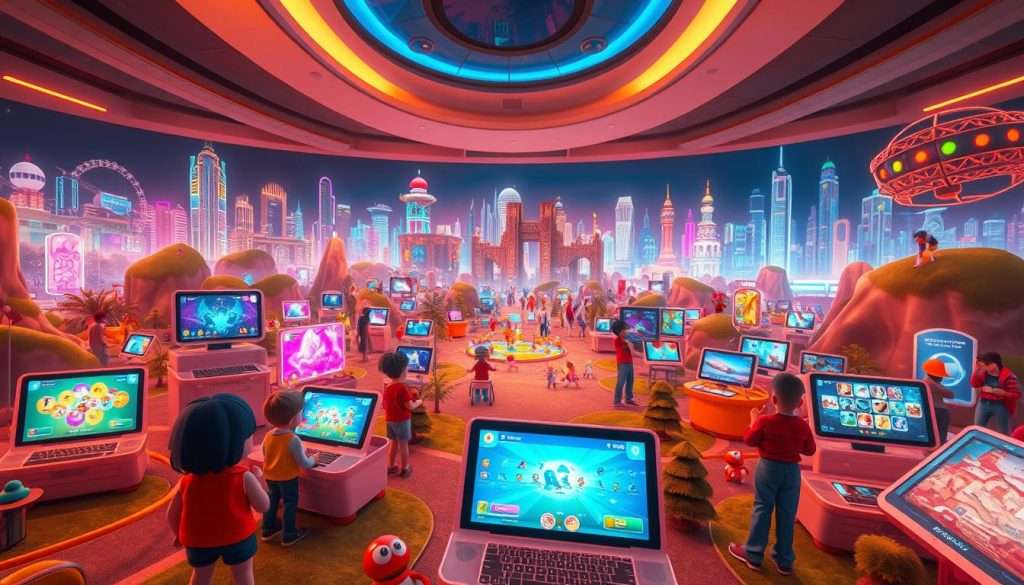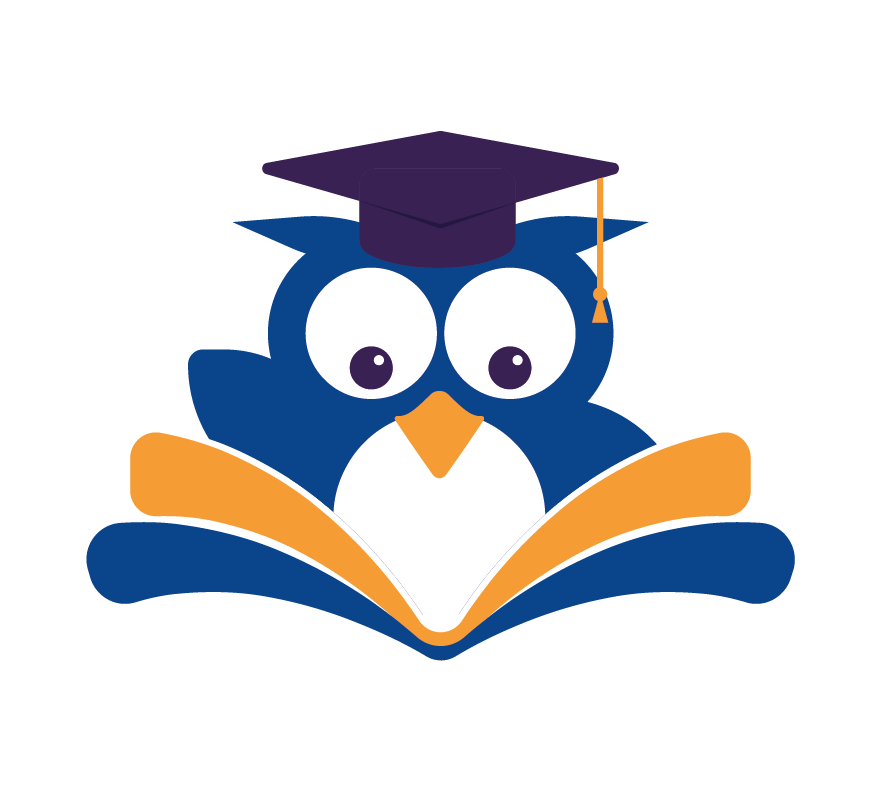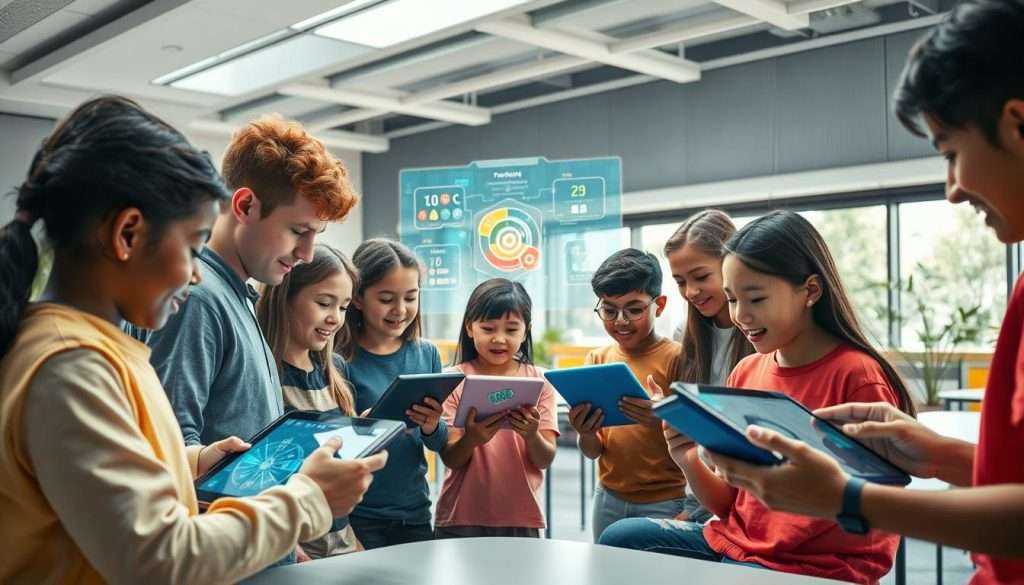We’re excited to explore how gamifying your learning can change the way you learn new skills! By adding game design to learning, we can make it more fun, interactive, and engaging.
Imagine being fully immersed in a world where learning feels like play. This isn’t just a fantasy; it’s the power of learning gamification in action. By using game mechanics, we can increase motivation, improve retention, and make learning more enjoyable.
Key Takeaways
- Discover how gamification can transform your learning experience
- Learn how to make studying more engaging and effective
- Explore the benefits of interactive education
- Understand how game design elements can boost motivation
- Find out how to apply gamification to your daily learning routine
The Science Behind Learning Through Play
Learning through play isn’t just for kids; it’s great for adults too. It uses game elements like competition and rewards to make learning fun. This method boosts motivation and helps remember what you learn.
What Makes Games Naturally Engaging
Games grab and keep players with clever designs. Competition pushes players to get better. Achievement and rewards give a feeling of success and benefits. Together, they make learning fun and engaging.
The Psychological Benefits of Game-Based Learning
Game-based learning has many benefits. It makes learning interactive and fun, reducing learning anxiety. This way, learning becomes enjoyable and more effective.
Why You Should Gamify Your Learning Today
Gamification is changing how we learn, making it more fun and effective. By adding gamified lessons to your study routine, you can see big improvements in your learning. This method uses educational technology to make learning interactive and enjoyable.
Increased Motivation and Sustained Engagement
Gamification makes learning rewarding, boosting your motivation. Earning points, badges, or rewards for tasks keeps you engaged. This interactive learning method keeps you motivated, even with tough material.
Enhanced Knowledge Retention and Recall
Gamified learning involves repetition and practice, key for remembering info. It makes learning fun, helping you remember and recall better. This is great for complex subjects that need a solid base.
Development of Critical Thinking Skills
Gamification boosts critical thinking by offering challenges and puzzles. As you level up or complete quests, you learn to think strategically and make smart choices. This sharpens your problem-solving skills, preparing you for life’s challenges.
Using innovative learning methods like gamification can change your learning experience. It helps you reach your goals more effectively.
The Core Mechanics of Effective Learning Gamification
Learning gamification works best when we understand game dynamics in schools. Game dynamics are the interactions and feedback loops in games that keep players engaged. By using these dynamics, teachers can make learning fun and effective.
https://www.youtube.com/watch?v=vQ8sl26NhfU
Understanding Game Dynamics in Educational Contexts
In schools, game dynamics create an environment that encourages students to participate and engage. These dynamics include feedback, progression, and challenge. They work together to motivate learners. By knowing how these elements interact, teachers can design fun and effective learning experiences for all students.
Distinguishing Between Games and Gamification Techniques
Gamification adds game elements to non-game settings, while game-based learning uses full games for learning. Gamification might include points or badges in a learning module. Game-based learning, on the other hand, uses the whole game as a learning tool. Knowing the difference is key to making your learning experience engaging.
| Characteristics | Gamification | Game-Based Learning |
|---|---|---|
| Definition | Applying game elements in non-game contexts | Using complete games as educational tools |
| Examples | Point systems, badges, leaderboards | Educational games, simulations, interactive stories |
| Focus | Enhancing engagement through game elements | Learning through gameplay and immersion |
How to Gamify Your Learning: Step-by-Step Guide
Ready to make learning fun? Let’s explore how to gamify your learning! It turns learning new skills into a fun, engaging journey. “The key to successful gamification is to make it personal and relevant,” say educational technologists.
Step 1: Define Clear Learning Objectives
To begin, set what you want to achieve. This means setting clear learning goals.
Short-term vs. Long-term Goals
Know the difference between short-term goals and long-term goals. Short-term goals are quick wins, like finishing a course module. Long-term goals, like mastering a new language, take more time and effort.
Making Goals Measurable and Achievable
Make sure your goals are measurable and achievable. Instead of “I want to be better at math,” say “I will solve 10 math problems daily.” This makes your goals clear and trackable.
Step 2: Select Appropriate Gamification Elements
With your goals in mind, pick gamification elements that fit. This could be point systems, badges, or leaderboards. Choose what motivates you the most.
Step 3: Design Your Personal Learning Game System
Next, create a system with your chosen elements. For example, you could have a leveling up system. You move up levels after finishing tasks. “Gamification is not just about making learning fun; it’s about making it effective,” experts say.
Essential Gamification Elements to Implement
The key to successful gamification is knowing and using the right elements. These elements make learning fun and challenging. By adding game design to learning, we make it more engaging.
Building Point Systems and Achievement Badges
Point systems and achievement badges are key in gamification. They give learners instant feedback and a sense of achievement. Earning points and badges motivates learners to keep going.
For example, Duolingo uses points to encourage daily practice in language learning.
Creating Progression Levels and Advancement Paths
Progression levels and advancement paths show learners where they’re going. As they move up, they feel a sense of accomplishment. This keeps learners engaged for a long time.
For instance, apps for professional skill development use levels to guide learners through different stages.
Designing Engaging Challenges and Quests
Challenges and quests make learning exciting and meaningful. They can be simple tasks or complex projects. They fit different learning goals.
Daily Challenges for Consistent Practice
Daily challenges help learners practice regularly. They are short tasks that reinforce what they’ve learned.
Long-term Quests for Deeper Learning
Long-term quests, though, push learners to apply what they know over time. They involve more complex tasks and projects.
| Gamification Element | Purpose | Example |
|---|---|---|
| Point Systems | Immediate feedback and motivation | Duolingo’s point system |
| Progression Levels | Long-term engagement and progression | Professional skill development apps |
| Challenges and Quests | Excitement and purpose | Daily challenges and long-term projects |
Top Digital Tools That Gamify Your Learning Experience
In today’s digital world, making learning fun is easier than ever. Thanks to many new tools, education is becoming more engaging and interactive. Let’s look at some top tools that are changing education.
Language Acquisition Platforms
Learning a new language is now more fun with apps like Duolingo, Babbel, and Memrise. They use points, badges, and leaderboards to keep you motivated. For example, Duolingo’s fun lessons and daily challenges make learning a language enjoyable.
- Duolingo: Known for its gamified approach to language learning.
- Babbel: Focuses on conversational skills through interactive exercises.
- Memrise: Uses a variety of user-generated content and gamification.
Professional Skill Development Applications
Apps like LinkedIn Learning (formerly Lynda.com) and Coursera help professionals grow their skills. They offer courses with fun elements like quizzes and projects. Plus, you get a certificate when you finish, which is a great motivator.

Subject-Specific Educational Games
There are many educational games for specific subjects like math, science, and history. Sites like Khan Academy and National Geographic Kids make learning fun. They’re great for students and teachers to add to their lessons.
Using these digital tools can make learning more fun and effective. Whether you’re learning a new language, improving your skills, or exploring new subjects, there’s a gamified tool for you.
Designing Reward Systems That Drive Motivation
A good reward system is essential for making learning fun. It keeps you motivated and engaged. A well-designed system can unlock your full potential.
Balancing Intrinsic and Extrinsic Motivators
A great reward system balances two types of motivators. Intrinsic motivators come from personal satisfaction. They keep you learning for the long haul. Extrinsic rewards, like badges, give instant satisfaction. They’re great for starting out.
Creating Meaningful and Progressive Rewards
Rewards should be meaningful and get better as you learn more. Progressive rewards show your growth and push you to do more. They keep you excited about learning.
Immediate vs. Delayed Gratification Techniques
When you get rewards matters. Immediate gratification boosts motivation right away. Delayed gratification rewards, like points for a big prize, build long-term commitment.
Personalizing Rewards for Maximum Impact
Personalized rewards are more effective. Tailor them to your likes and learning style. For example, if you’re competitive, leaderboards might motivate you. If you like something tangible, badges or certificates work better.
Overcoming Common Obstacles in Gamified Learning
When we explore gamified learning, we face obstacles that slow us down. Gamification is a great way to make learning fun, but it comes with its own set of challenges. To get the most out of interactive education, we need to tackle these issues head-on.
Strategies for Breaking Through Learning Plateaus
One big hurdle in gamified learning is hitting a plateau. To get past this, we can try a few things:
- Increase the difficulty level of challenges to stay engaged.
- Introduce new gamification elements to refresh the learning experience.
- Set new, more challenging goals to strive for.
By using these strategies, we can move past the plateau and keep making progress in our learning.
Maintaining the Balance Between Entertainment and Education
Another challenge is keeping the right balance between fun and learning. To do this, we should:
- Ensure that educational content remains the primary focus.
- Use gamification elements that support learning objectives.
- Regularly assess the effectiveness of the gamified learning approach.
By finding the right balance, we can create a fun and effective learning experience. This way, we can make the most of educational games.
Success Stories: Real People Who Transformed Their Skills Through Gamification
See how people like you have changed their skills with gamification. They used game-based learning and innovative learning methods. This helped them succeed in their careers and studies.

Career Advancement Through Gamified Professional Development
Professionals have used gamified learning to move up in their careers. For example, educational technology training has given them new skills. This makes them stand out in the job market.
Some benefits are:
- Increased motivation and engagement
- Improved knowledge retention and application
- Enhanced career prospects through demonstrated skill mastery
By adding game design to their learning, professionals stay ahead. They reach their career goals.
Academic Excellence Through Learning Games
Students have also seen big benefits from gamified learning. Educational games make tough subjects fun and easy to get. This leads to better grades.
Some key results are:
- Better understanding and retention of material
- Improved problem-solving skills and critical thinking
- Increased confidence and enthusiasm for learning
With gamification, students do well in school. They also develop a love for learning that lasts a lifetime.
Tracking and Measuring Your Gamified Learning Progress
Starting your gamified learning journey? Tracking your progress is key to staying motivated and reaching your goals. It helps you see where you’re doing well and where you need to improve. This way, you can make smart changes to boost your learning.
Setting Up Effective Progress Tracking Systems
To track your progress well, you need a system that gives you clear, useful data. You can use tools like learning management systems (LMS), spreadsheets, or gamification platforms. Pick metrics that matter to your learning goals, like how well you do on tests or how much time you spend on tasks.
Using Data to Refine Your Learning Approach
With a tracking system, you can improve your learning. Look at your progress to find out what you’re good at and what you need to work on. Then, adjust your learning plan to focus on your weaknesses.
Identifying Strengths and Weaknesses
Looking at your data, you’ll see where you shine and where you need to get better. For example, you might find you ace quizzes but struggle with hands-on tasks.
Making Data-Driven Adjustments
Knowing your strengths and weaknesses, you can tailor your learning. Spend more time on tough subjects, find extra resources, or change your study schedule.
| Learning Aspect | Strength/Weakness | Action Plan |
|---|---|---|
| Multiple-Choice Quizzes | Strength | Continue current study habits |
| Practical Assignments | Weakness | Allocate additional practice time |
| Theoretical Knowledge | Strength | Apply knowledge to practical tasks |
Advanced Gamification Strategies for Lifelong Learners
As we continue on our learning journey, it’s essential to explore advanced gamification strategies. These can keep us engaged and motivated. Advanced strategies can elevate our learning experience, making it more enjoyable and effective.
One of the most impactful ways to enhance your learning is by implementing social and collaborative learning games. This approach not only makes learning more enjoyable but also provides opportunities for sharing knowledge and learning from others.
Implementing Social and Collaborative Learning Games
Social learning games encourage interaction with others who share similar interests or goals. By participating in these games, you can gain new insights, receive support, and stay motivated. To implement this strategy, look for online platforms or apps that facilitate group learning and collaboration.
Creating Immersive Narrative-Based Learning Journeys
Another advanced strategy is to create immersive narrative-based learning journeys. This involves crafting a story around your learning objectives, making the process more engaging and memorable. You can achieve this by setting up a narrative framework that guides you through your learning path, with challenges and rewards along the way.
By incorporating these advanced gamification strategies into your learning routine, you can experience a more interactive education. Enjoy the benefits of game-based learning. This can lead to a more fulfilling and effective learning experience.
Conclusion: Revolutionize Your Learning Journey Through Gamification
We’ve looked into how gamification changes learning. It uses game elements to make learning more fun and effective. This approach boosts your motivation and helps you remember what you learn better.
Using games in learning is not just a new idea. It’s a proven way to make learning more fun and successful. With the right tools and rewards, you can learn new things and reach your goals.
When you start your gamified learning, mix fun with learning. Use technology and games to make learning your own. This way, you’ll enjoy learning and see results.
So, why wait? Begin making your learning fun today. Discover a new way to learn that’s engaging, effective, and rewarding.

